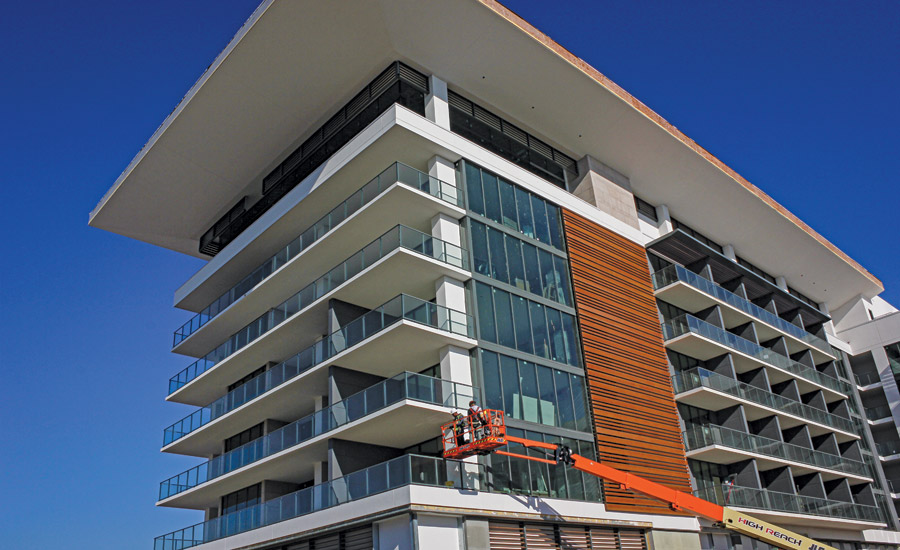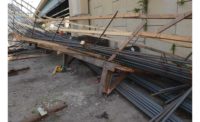Digging Deeper | Hospitality
Building Orlando Resort, PCL Gets Creative to Beat Supply-Chain Snags
Building a luxury hotel during the height of supply-chain disruptions forced contractors to work around numerous procurement issues

The Conrad Orlando, targeted for an August 2023 completion, has been designed to achieve 5-star ratings for its amenities.
Photo courtesy PCL Construction Co.
Like the first giddy riders cued up for the newest, most spectacular theme park attraction, members of the Dart Interests-PCL Construction team couldn’t have fully envisioned the wild ride through the construction supply chain that awaited them as they broke ground on the $273.7-million Conrad Orlando luxury hotel and resort. They were just excited to be there.
It was March 11, 2021, after all, and pandemic uncertainty still permeated the Central Florida hospitality sector, with numerous projects having been paused or even halted. A press announcement of the groundbreaking showed project officials maintaining social distancing and celebrating appropriately with an elbow bump. Christopher Kelsey, president of Dart Interests, the project owner, stated, “We are thrilled to celebrate the groundbreaking of the Conrad Orlando today, coming one step closer to welcoming our first guests in summer 2023.”

HKS, the project’s architect, incorporated various curving features into its design.
Photo by Thomas Watkins Photography and the Stowell Co.
As construction began in earnest on the 433-room Conrad Orlando—the centerpiece of Dart’s emerging Evermore Orlando Resort—project team members were excited, too. And with good reason.
The luxury Conrad Hilton Orlando—so named for Hilton Hotels’ founder—is designed and built to “4.5- to 5-star” level of finishes and amenities, says Kent Findley, Dart vice president for design and construction. Of the hotel’s 433 rooms, 51 will be suites. Also, due to its close proximity to Walt Disney World and Universal, Dart chose architect HKS to design the building to better accommodate vacationing families by including 10 four-bedroom family suites.
“We used a lot of technology to really put ourselves into the space.”
—Christian MacCarroll, Principal and Studio Design Leader, HKS
Other amenities include a spa and dining options that include a rooftop restaurant. In all, the Conrad’s total square footage totals more than 529,000, including 75,000 sq ft of convention space.
Also included as part of PCL’s contract is the Flats at Evermore, located adjacent to the Conrad and comprised of three five-story buildings designed as multifamily vacation rentals. One of the three buildings contains 54 four-bedroom, four-bathroom units, while the other two buildings include 50 four-bedroom, four-bathroom units.
"It's a big project, but it's got such variety," says Findley. "We think this is delivering something uniquely different."
Notably, unlike other hotel owners, Dart plans to own the property permanently, with both the Conrad and the Flats at Evermore delivering steady revenue for the company, says Findley.
Creating Wow Moments
Leading an early February project tour of the site, Findley points out the building’s design seeks to create a “wow moment” as guests first arrive. Upon arriving, guests will enter via the hotel’s second floor and will immediately see beyond—through a large, seamless section of glass—to the resort’s 20-acre beach complex and 8-acre crystalline water amenity, featuring so-called zero-entry or walk-in swim areas, bars, cabanas and private fire pits.
Achieving an elevated entrance in mostly flat Central Florida required the usual steps of building up the site via grading in dirt and other fill material. Notably, though, local zoning restrictions for the site—which is located near a neighborhood of townhomes—restricted the building’s height to 70 ft, says Christian MacCarroll, principal and design studio leader for HKS, Orlando.
Examining the details of the code, HKS and team learned that the 70-ft elevation limit started from the structure’s entrance, specifically where fire trucks and other emergency vehicles would enter. By elevating the entrance 20 ft, the project team was able to design the building to reach a 90-ft height.

The resort will feature an 8-acre crystalline water feature as part of its 20-acre beach complex.
Rendering courtesy HKS Inc.
“That was the way we were able to creatively squeeze all the program into a really tight site,” MacCarroll says. “We really had to stretch it out.”
To ensure that guests’ views of the lagoon and beyond were available from all sections of the complex—including, importantly, from guest rooms—the building is shaped along a curve. HKS used virtual reality technology to visualize the hotel’s “vistas” from varying perspectives across 360 degrees, says MacCarroll.
Early on, HKS focused on “establishing primary, axial vistas across the lagoon,” says MacCarroll, adding that the lagoon served as a focal point. “What does that sight line look like along the lagoon edge as you walk 360 degrees around? What did that experience look like?”
To that end, he says, “We used a lot of technology to really put ourselves into the space, whether it be some of the larger spaces or the guest rooms.”
Also important was designing for energy efficient building performance, MacCarroll says. To that end, the building features large overhangs on each floor, making it “self-shading,” as well as insulated glass with high-performance coatings and smart energy controls, he adds.

The architect utilized large roof overhangs to enhance shading for guests and to increase energy efficiency.
Photo courtesy PCL Construction Co.
Project Team Resiliency
At that moment in early 2021, kicking off construction of a unique luxury hospitality project had to feel good to PCL and the rest of the project team.
As Rick Goldman, vice president and district manager for PCL, noted at the March groundbreaking ceremony, “This new resort represents the resiliency of the hospitality industry. While COVID-19 has had an unprecedented impact on the travel industry, companies like Dart Interests continue to drive opportunities for new development, growing a network of resort properties to best accommodate guests as demand for travel resumes. PCL is proud to have begun work on this project.”
Starting work on this premier project had to feel good to PCL’s general superintendent Branden Stephan and senior project manager David Keeler. Soon enough, though, the two builders would find themselves facing a sometimes-nightmarish string of supply-chain challenges the likes of which they could have never imagined—and will likely never forget.

A view of the project as it appeared in August 2022.
Photo by Thomas Watkins Photography and the Stowell Co.
The project started off as usual for PCL. Loaded with plenty of historical data from the contractor’s experience delivering Orlando’s JW Marriott, multiple Disney resort hotels, among many others, and with a penchant for self-performing as much work as possible, the contractor built a schedule to its comfort level. To which Dart responded, “Can you go faster?” says Keeler. “Of course,” replied PCL, adjusting the schedule slightly.
Still, both PCL and Dart knew well that historical data didn’t represent the market conditions of 2021, especially related to material and equipment procurement.
When Dart awarded the contract, Keeler says, “Prices were going through the roof, so in the first two months we bought out every single scope on the job” that it could to lock in prices and avoid, as much as possible, escalated costs for key materials. And with the site measuring 800 acres, Dart had plenty of room for PCL and team to store materials if needed.

The zero-entry— or walk-in—water feature is being delivered by Crystal Lagoons.
Keeler says the experience to date “has forced us to rethink what managing procurement really means.”
The old approach of having trade contractors filling out schedule spreadsheets is “just not enough anymore,” he adds. “We’re down to tracking shipping vessels and really understanding logistically not only where the material is coming from but how it gets here.”
On a project designed to luxury standards, featuring interior materials coming from all over the world, PCL has had to build up its procurement efforts, with teams charged with keeping track not only of deliveries, but also monitoring the status of various ports around the world, among other tasks.
“It’s just so much more detailed than I ever imagined we’d ever get into in the construction industry,” Keeler says. “This is just the way we operate now.”
Stephan, the PCL superintendent, says, “We think we’re past the procurement problems. We’ve tracked everything on the electronic side, so hopefully all of that is behind us.”
Getting sufficient workforce is the main challenge now, he adds. Asked how the procurement issues played out, though, Stephan recalls a string of anxious moments that plagued the project for awhile.
“We’ve gone from [suppliers saying] ‘We don’t have it; we can’t get it,’” Stephan recalls. “We really jumped around.” Troubles with roofing procurement likely caused the biggest headaches due to the other issues caused by not being able to dry in the structure.
Originally designed with a roof featuring tapered insulation, PCL switched it up early during the preconstruction phase because they were hearing there were issues getting fasteners for tapered insulation roofing.
Thinking “we’re going to be smart,” PCL switched to lightweight insulating concrete, Stephan says. “But I think everybody else did the exact same thing.”
The project has “forced us to rethink what managing procurement really means.”
—David Keeler, Senior Project Manager, PCL Construction Co.
However, he adds, roofing manufacturers began limiting production of TPO (thermoplastic polyolefin) to just one type.
“Basically everything had to be felt-back TPO,” Stephan says. And as luck would have it, the roofing manufacturer working on this project had its TPO machine break down, requiring replacement parts from Germany.
Next, the contractor had trouble procuring holey board foam insulation. The roofing supplier was able to procure the material by gathering up surplus not used on previous jobs. “That stuff turned to gold,” Stephan says of the cost escalation.
Similar availability issues plagued the placement of the metal deck that tops the hotel’s convention space. Even finding the right type of portland cement was an issue at one point, says Stephan.
And while procurement issues have settled down to some degree, PCL was still experiencing challenges recently related to glass.
In February, for instance, the contractor was being forced to use four different suppliers to purchase glass “because you can’t get all of the pieces from one supplier anymore because that guy is limited to an amount of procurement that he can do,” Stephan says. “Everything seems to be in allotments right now.”
Overall, says Keeler, the Evermore project has been a learning experience.
"We have definitely explored new territory in our project team's resiliency," he says. Construction projects of this size and quality will always have challenges that we work to overcome daily, but with the post-COVID era of global procurement and also labor shortages, this team has been remarkable in its ability to adapt and provide creative new ways to keep the project progressing."
As would be expected considering all of the availability issues, PCL’s project timeline has been pushed back, but just slightly. At the March 2021 groundbreaking, for instance, Dart noted a target completion date of “summer 2023.” Now, PCL is projecting completion by August, with Dart planning a soft opening for the Conrad a couple of months prior to that.
When asked by ENR whether the project will complete in time, Dart's Findley says, "Brandon says we will. I'm counting on him."
Maybe then PCL’s Stephan and Keeler can procure themselves some downtime.


